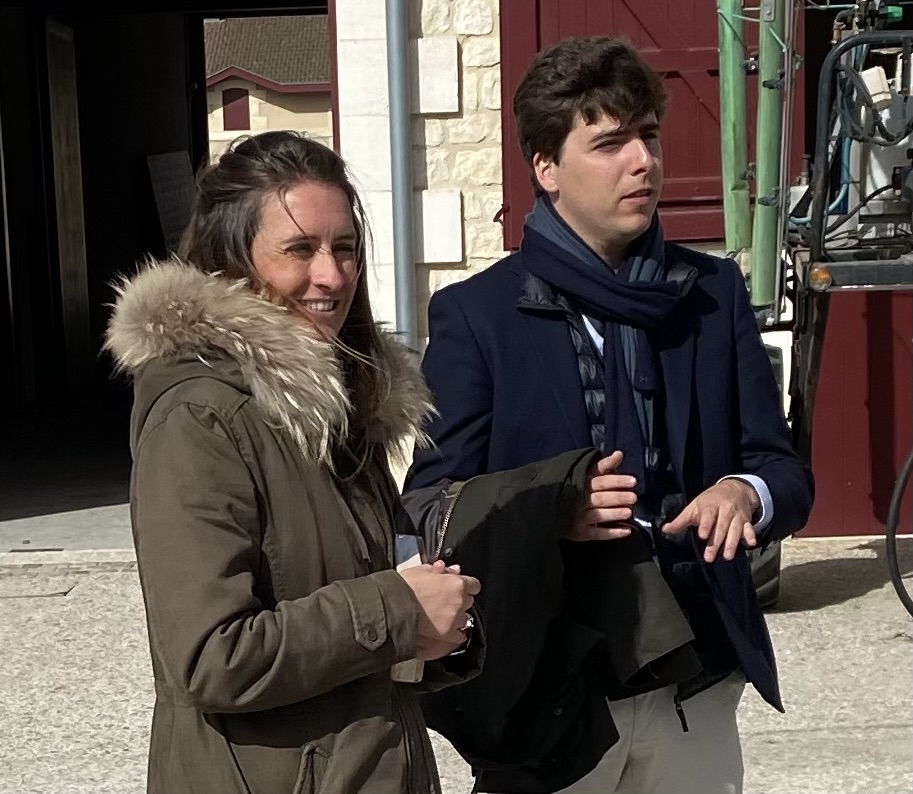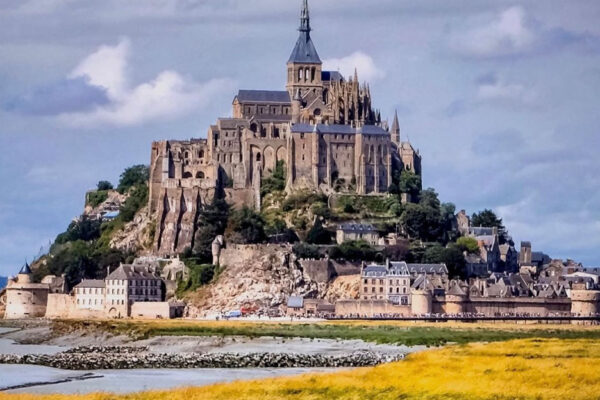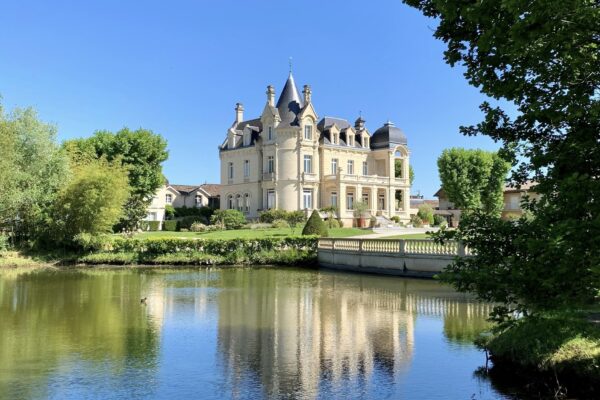Château Pontet-Canet: Unplugged & Off the Grid

by Marla Norman & Michel Thibault
Among the many magnificent castles and First Growth estates in Pauillac, Château Pontet-Canet is distinctively anachronistic — and quite proudly so. Consisting of over 80 hectares (about 197 acres) Pontet-Canet is one of the largest Grands Crus Classés in the Médoc, with an annual production of 20,000 cases of the estate grand vin. More impressively, this vast vineyard is managed with biodynamic techniques, requiring long, backbreaking hours in the fields.
First time visitors to Château Pontet-Canet are often surprised to see that the property resembles a working farm — quite different from the glamorous tasting rooms of many other Bordeaux estates. Here, the stables housing the Brittany horses used to plow the fields have become a top attraction. The enormous animals are extraordinarily gentle and, when not working, enjoy the attention they receive from guests.
Château Pontet-Canet was the first first Grand Cru Classé estate of the Left Bank to achieve both organic and biodynamic certifications for 100% of its vineyard.
EARLY HISTORY
Jean-François de Pontet, royal governor of the Médoc, was the original owner of the estate. Pontet’s descendants continued to add to the property by purchasing adjacent vineyards, including a valuable tract from the Canet area — hence the name: Pontet-Canet.
Over 100 years later, the estate was acquired by Herman Cruse, a prominent Bordelais négociant. Cruse developed the winemaking facilities and established Pontet-Canet’s reputation for quality wine.
In 1975, Guy Tesseron bought the Château. At the time, the Tesseron family was (and still is) known for their cognacs. But they also owned Château Lafon-Rochet, a property in neighboring Saint-Estèphe. Additionally, Guy’s wife Nicole Cruse had grown up at Pontet-Canet, so the family was eager to re-acquire the estate. After almost two centuries, Château Pontet-Canet has belonged to only three families. In this era of corporate-owned châteaux, that fact again makes Pontet-Canet unique.
ALFRED’S LIFE-CHANGING GAMBLE
The summer of 1994 was unseasonably hot and dry. Alfred Tesseron, who had long been at odds with his father, Guy, over the vineyard management, decided to initiate a green harvest. Guy was furious when he discovered that Alfred had pruned the vines so heavily.
Undeterred, Alfred struck a bargain with his father. If the result of his intervention was a failure, he would leave the estate immediately. But, if it worked, he would take over as manager.

Alfred Tesseron, owner of Pontet Canet with Michel. Photo by Marla Norman.
Alfred’s determination and confidence paid off. The 1994 Pontet-Canet was one of the most-highly rated vintages the Château had ever produced. Alfred, along with régisseur Jean-Michel Comme, who had joined him in 1989, began to implement the new techniques they had been longing to try.
Pesticides were of course immediately banned and organic fertilizers used only on plots that required extra nutrition. Teams began to analyze and treat each vine individually.
Ironically, some of the “new technology” Alfred and Jean-Michel began to apply were decidedly old fashioned. Tractors were parked and instead horses were brought in to plow the fields. Horses are lighter, therefore gentler in the vineyards. And, since they never step in the same place twice, they constantly aerate the soil.
Pontet-Canet also has a dedicated “tisanerie” (herbal tea room) where biodynamic infusions and decoctions are prepared. Infusions, made from nettle, rosemary and chamomile are sprayed on the vines to enhance their natural defenses and promote their resistance to infections.
Other preparations include burying cow horns filled with manure, a natural fertilizer. Later the contents of the horns are diluted in water and applied as a spray to the vineyards. This spraying stimulates soil life, promotes deeper root growth, and contributes to the overall health and balance of the vines.
Alfred neatly sums up his approach: “The vines know what they need. Often we just get in the way.” And he adds: “I am not a winemaker. My team members are not winemakers either. As most of the work is done in the vineyards, we are growers. Our success and achievements at Pontet-Canet are due to our efforts in the vineyards, not the winemaking.”
PONTET-CANET UNPLUGGED
At harvest, grapes are picked by hand. At Pontet-Canet, there are no computers, no laser sorters — again, everything is done by hand. Berries macerate in concrete vats. There are no pump overs. All the fermentation tanks are situated just beneath the first floor, while destemmed berries drop into the tanks using gravity. Malolactic fermentation takes place in vat.
To age their wine, Alfred uses a combination of new and one-year old French oak barrels along with 100 clay amphorae. Approximately 25% of the total harvest is aged in the amphorae, with the remaining percentage distributed among the barrels.

Approximately 25% of the total harvest at Pontet-Canet is aged in one-hundred amphorae. Photo by Marla Norman
One-hundred clay amphorae were a hefty investment, but the Pontet-Canet team feel that limiting oak is essential and the added minerality from the clay is an obvious benefit. Moreover, since the amphora jars are porous, they allow for limited contact with air, similar to what might occur during micro-oxygenation.
Wall sockets for electricity are almost non-existent at the Château. Lighting is now powered by geothermal energy that emanates from geothermal boreholes in the vineyards. The process works by using a polyethylene pipe to circulate water from and to geothermal heat pumps, simultaneously reducing their ecological thumbprint and removing any effects that electromagnetism might have on the wine.
As Alfred puts it: “Biodynamics is much more than a technique. It’s a way of reasoning — a philosophy of life.”
In 2010, Pontet-Canet became the first Grand Cru Classé of the Left Bank to achieve both organic and biodynamic certifications for 100% of its vineyard. Alfred’s efforts have paid huge dividends with top ratings, frequently higher than his First Growth neighbors.
More importantly, from Alfred’s perspective, is the enormous group of collectors who have come to treasure the full-bodied freshness and distinctive personality of Château Pontet-Canet. Robert Parker awarded both the 2009 and 2010 vintages 100-points, writing: “You are likely to see many more (biodynamic vineyards) given the success that Tesseron seems to be having at all levels, both in his vineyards and in his fermentation / winemaking. An astounding, compelling wine with the classic Pauillac nose — more often associated with its cross-street neighbor, Mouton-Rothschild — with creme de cassis, violets and other assorted floral notes. The wine has off-the-charts massiveness and intensity but never comes across as heavy, overbearing or astringent. The freshness, laser-like precision, and full-bodied, massive richness and extract are simply remarkable to behold and experience.”

Justine & Noé Tesseron now manage the family estates. Photo by Marla Norman.
THE NEXT GENERATION
Alfred now manages Château Pontet-Canet with his daughter Justine, who shares her father’s passion for “growing grapes” and his vision for continued use of biodynamic methods.
The 2018 vintage proved to be a huge test of that commitment. Record breaking rain caused mildew damage on a massive scale. The harvest that year was excruciatingly small — a paltry 8 hectoliters per hectare instead of the usual 35 to 40 — a 75% loss overall.
The financial toll was staggering, but the family never wavered. To change course would mean not only throwing away years of work, but an entire way of life. Ultimately, the 2018 vintage was tiny but highly-rated and 2019 was a record harvest.
Meanwhile, the Tesseron empire continues to expand. In 2016, Alfred bought the Pym-Rae Estate in the Mount Veeder appellation of Napa Valley. Interestingly, the property is 653 acres (260 hectares), however only 18.4 (7 hectares) are planted in vines — primarily Cabernet Sauvignon. Located next to the Hood Mountains Regional Park, Pym-Rae boasts spectacular vistas, with lakes, rivers and abundant wild life. The late Robin Williams originally owned the estate, naming it for his children.
Noé Tesseron, Alfred’s son is the estate manager. (Noé also manages Tesseron Cognac.) The same biodynamic techniques that have been so successfully established at Pontet-Canet have been implemented at at Pym-Rae. Alfred jokes that a large stable and barn were one of the main reasons he purchased the estate — horses could be brought in immediately to plow the fields. The ponies are obviously doing their job — in 2018, Pym-Rae received Demeter biodynamic certification for 100% of its grapes.
Where the Tesseron family heads next is anyone’s guess. Whatever the project, it will be unique and foster the individualistic style this group always champions — and it will have plenty of horsepower!








